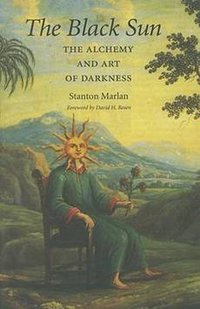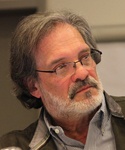The Art of Transformation: Images, Dreams, and Alchemy—An Interview with Jungian Analyst, Stanton Marlan
A Guest Blog Post by Bonnie Bright, Ph.D.
 For Stanton Marlan, a Jungian analyst and author of the iconic tome, The Black Sun: The Alchemy and Art of Darkness, his interest in alchemy may be traced in some part to his childhood stone collection. As a child, Marlan used to use his stones to “write” in wonderful colors, and delighted in the way each had a certain capacity to express themselves in a unique way without crumbling in the process.
For Stanton Marlan, a Jungian analyst and author of the iconic tome, The Black Sun: The Alchemy and Art of Darkness, his interest in alchemy may be traced in some part to his childhood stone collection. As a child, Marlan used to use his stones to “write” in wonderful colors, and delighted in the way each had a certain capacity to express themselves in a unique way without crumbling in the process.
The stones, which he kept in front of his grandmother’s house where he lived, became a very early “image” for Marlan, carrying a great deal of meaning. When his grandmother determined the stones were cluttering the front yard and threw them away, it resulted in a sense of profound loss for the boy whose colorful stones were so rich and valuable to him. In some deep way, Marlan reflects, the search for the philosopher’s stone, or the search for meaning in stones, was an early imprint on his mind as a young child.
Later, Marlan became fascinated with Jung’s work on alchemy, and longed to know more about what the alchemical illustrations meant from a psychological, emotional, and spiritual perspective. Jung opened the doors to understanding alchemy in a way that earlier scholars had not done, Marlan points out. In the practice of alchemy, the alchemist tried to transform matter, specifically by changing a base substance into a valuable substance, such as turning lead into gold.
Jung’s contribution is that he recognized that what the alchemists were attempting to do actually related to symbolic and spiritual life. To put it simply, Jung observed that one could work with a depressive personality—one weighed down in its own substance and weight—and through varying procedures, transform it into a golden one—shining, valuable, and developed. Jung’s understanding of alchemy as a transformative psychological process was an early imaginal way of understanding the depths of the unconscious and the transformation processes that he was developing in his own work in depth psychology and in the individuation process.
When Marlan first read Jung, it activated a very deep place hearkening back to his childhood where the world was alive, changing and transforming; where substances mattered, and where those substances produced a sense of soul and spirit. When Marlan made the connection about how Jung understood alchemical processes as psychic transformative processes, he was hooked. Marlan, who was a plenary speaker at the weekend symposium, “Ars Alchemica: The Art and Alchemy of Transformation,” August 25-27, 2017, at Pacifica Graduate Institute, discussed Jung’s valuable work with alchemy and is role in depth psychology in his talk, “Divine Darkness and Divine Light: Alchemical Illumination and the Mystical Play between Knowing and Unknowing.”
Perhaps the discovery of alchemy for Marlan was a way of bringing back, or re-finding those stones that were lost to him. The process of transformation, also referred to as the individuation process, often requires loss and going back to those early images in order to make meaning. To begin to unpack those images is to begin to understand the loss we experienced and to surrender to it to allow the transformation of those images and to move forward.
Psychoanalysts talk about “lost objects of desire,” Marlan notes, and how those lost objects set the stage for the search for what will complete us—what we lost and what we need to find. These kinds of ever-present archetypal images give us what's missing in our current personalities. They open up the possibility to reach beyond into the depths of an imaginal life. “Alchemy is so rich in that regard,” he maintains. “It's a wonderful system of magical transformation that pulls the soul forth into the work. It speaks directly to the depths through the images that are present there.”
 In his book, “The Black Sun,” Marlan introduces an idea he refers to as the “benevolence of darkness.” In western culture, darkness can represent something evil or negative; something we try to avoid. It is commonly linked to depression. In our spiritual traditions, we try to move from darkness to light in our spiritual traditions, attempting to escape away from or transcend what is actually a place of soul, which the alchemists call the nigredo: the blackness. In fact, darkness may also be seen as an image of the unconscious itself.
In his book, “The Black Sun,” Marlan introduces an idea he refers to as the “benevolence of darkness.” In western culture, darkness can represent something evil or negative; something we try to avoid. It is commonly linked to depression. In our spiritual traditions, we try to move from darkness to light in our spiritual traditions, attempting to escape away from or transcend what is actually a place of soul, which the alchemists call the nigredo: the blackness. In fact, darkness may also be seen as an image of the unconscious itself.
The alchemists were very conscious of the fact that to achieve blackness is an accomplishment, to get to the place where we really are in the dark, in the unknowing—in the unconscious, Marlan insists. Darkness is a fundamental place of the soul. We have to enter the nigredo state in order to come out of our conscious personalities and deepen into the depths that darkness represents.
 The primordial image of the black sun is a strange one because it represents darkness, but it's also illuminated, Marlan reveals. It contains a darkness that has a shine, which can be shown to us if we stick with the depths and don’t try to rush through them. This process gives the soul an opportunity: by not attempting to distance ourselves from darkness, which is often accompanied by difficulty, pain, or fear, and by facing those experiences instead, they can open us to another level.
The primordial image of the black sun is a strange one because it represents darkness, but it's also illuminated, Marlan reveals. It contains a darkness that has a shine, which can be shown to us if we stick with the depths and don’t try to rush through them. This process gives the soul an opportunity: by not attempting to distance ourselves from darkness, which is often accompanied by difficulty, pain, or fear, and by facing those experiences instead, they can open us to another level.
In modern western culture, we’re not trained or conditioned to be able to embrace that darkness or even to tolerate it for the most part. Marlan offers some ideas about how we can take this understanding of the value of the darkness and turn that into an experience that becomes positive to gain the benefits of what that darkness provides.
What becomes truly transformative is if we can learn to slow down, to stick with images, and to stay with things that initially we feel uncomfortable about, Marlan acknowledges. Whether we do that through psychoanalysis, meditation, or any other spiritual process that interests us, we begin to experience pieces of this darkness that manifest in feelings, fantasies, and opportunities for deepening that we wouldn't otherwise experience. Once that process starts, it motivates the individuation process, and ultimately we understand it's not something that is going to devour us.
In this way, we develop patience. We learn how to stick with things, and that work begins an illumination process. Working with the darkness symbolized by the black sun often brings in its wake, tragic, painful, difficult experiences. Learning to stay with those experiences and the emotions they uncover moves the soul in ways that can be surprising. Darkness has a light of its own, which is revealed by staying with the darkness until we begin to experience the light that illuminates; light which enhances our experience of connection to the life that is in, around, and beyond us. This opens up a whole sphere of understanding that comes from staying with rather than going away from.
 Marlan has found dreamwork to be fundamental in the alchemical process. Dreams carry fundamental images that challenge and open the soul. If we respect the dream enough, we enter into it in a state of not knowing rather than knowing. "It's the empty cup that can receive, not the full cup," he says, citing a Zen saying. You have to maintain a willingness to enter a dream and let it sit with you—just as you might sit with darkness, he asserts. It's a kind of sitting with the unknown, and letting the images come and affect your understanding in such a way that they start to take the lead. Dreams are like messages from the soul—psychic realities in their own right.
Marlan has found dreamwork to be fundamental in the alchemical process. Dreams carry fundamental images that challenge and open the soul. If we respect the dream enough, we enter into it in a state of not knowing rather than knowing. "It's the empty cup that can receive, not the full cup," he says, citing a Zen saying. You have to maintain a willingness to enter a dream and let it sit with you—just as you might sit with darkness, he asserts. It's a kind of sitting with the unknown, and letting the images come and affect your understanding in such a way that they start to take the lead. Dreams are like messages from the soul—psychic realities in their own right.
Through our relationship to “otherness” perceived through dreams, our world expands considerably. It multiplies and enriches. It's important that one finds a personal way of connecting with the unconscious, of, "coming to terms with the unconscious", as Jung says, and coming to terms with dreams. When one forges a relationship with the unconscious, an inner dialogue goes on between you and the imaginal life.
In our conversation, Marlan, who refers to “the psychology of mysticism,” recounted two very powerful “big” dreams he’s had which seemed to have mystical qualities to them. In one, he dreamed about two rabbits that were caught in a window well of his house. In working with the dream, he looked at it from a personal perspective, thinking, "What of my own inner rabbits have fallen into a place where they're caught, or stuck?" Later that day, while out working in the garden, to his great surprise, he found two dead rabbits in his window well. This powerful experience helped him realize that dreams sometimes refer to the objective psyche and to the objective world in a way that is quite incomprehensible. Realizing that one has to look to the larger perspective, in addition to the deepest personal perspectives, is a critical aspect dream life.
 In another potent story, Marlan recounts how he visited Jung's house in Zurich and noticed lots of stones around. Since he loves stones, he started picking some up, thinking how much he’d like to have something to remind him of his visit. That night, he had a dream in which he knocked at the door of Jung’s house, which was answered by Emma, Jung’s wife. Upon introducing himself and explaining how much he admired Jung, Marlan explained to Emma how he’d really like to have something of Jung’s to take home with him. Emma left and reappeared with a pair of Jung's shoes, which she placed by Marlan’s feet. Overwhelmed by what was unfolding in the dream, Marlan stepped into Jung's shoes, only to find they were way too big! The dream was a critical recognition of the inflation he was carrying, Marlan laughs, and suddenly everything he had projected onto Jung, the stones, and the identification with Jung broke up and opened up a much more personal connection to Marlan’s own depths and destiny. Dreams can be very powerful awakening opportunities, Marlan concludes.
In another potent story, Marlan recounts how he visited Jung's house in Zurich and noticed lots of stones around. Since he loves stones, he started picking some up, thinking how much he’d like to have something to remind him of his visit. That night, he had a dream in which he knocked at the door of Jung’s house, which was answered by Emma, Jung’s wife. Upon introducing himself and explaining how much he admired Jung, Marlan explained to Emma how he’d really like to have something of Jung’s to take home with him. Emma left and reappeared with a pair of Jung's shoes, which she placed by Marlan’s feet. Overwhelmed by what was unfolding in the dream, Marlan stepped into Jung's shoes, only to find they were way too big! The dream was a critical recognition of the inflation he was carrying, Marlan laughs, and suddenly everything he had projected onto Jung, the stones, and the identification with Jung broke up and opened up a much more personal connection to Marlan’s own depths and destiny. Dreams can be very powerful awakening opportunities, Marlan concludes.
In closing, Marlan, who is a training and supervising analyst with an Inter-Regional Society of Jungian Analysts reveals how alchemy, dreamwork, and illumination come into play in his capacity as a trainer for up-and-coming analysts. “What one brings to good work is not some theories or ideas, but one's own self,” he believes. One’s own individuation—or at least one’s own experiences of life—reveals a message from the unconscious that radiates from contact with people in the training process. One learns a lot in training, not just from ideas, but from experience of others, and from seeing how they work. When you open your own self in some way, just like with the philosopher's stone, there is a radiation that people begin to identify with parts of psyche and soul, that may get catalyzed.
Marlan’s goal as a trainer is to help trainees take that up and develop it in their own individuation process, resulting in truly initiatory work. We are introduced into our own depths, into the unconscious, into the soul, into what's beyond our personal selves, and into a transpersonal connection with a larger sense of life. “Arriving there through dreams, through the inner life, and through the transformative process is what the training is ultimately all about in its deepest sense,” insists Marlan (whose new book is called “The Philosopher’s Stone: The Alchemy and Art of Illumination”).
It’s also what each of us is called to do, whether we’re formally in training as a Jungian analyst or not, I catch myself thinking. After all, the inner life is the only life that can ultimately provide us with the transformation and meaning to be found in the depths.
Listen to the full audio interview with Stanton Marlan, Ph.D., here (approx. 32 mins):
Learn more about Marlan’s book, The Black Sun: The Alchemy and Art of Darkness
Learn more the Jungian and Archetypal Studies Specialization at Pacifica Graduate Institute
 Stanton Marlan, PhD, ABPP, LP, is a Jungian analyst and clinical psychologist in private practice in Pittsburgh, PA. Dr. Marlan holds doctorates in both Clinical Psychology and Philosophy, and is an Adjunct Clinical Professor of Psychology at Duquesne University and senior supervisor at its psychology clinic.
Stanton Marlan, PhD, ABPP, LP, is a Jungian analyst and clinical psychologist in private practice in Pittsburgh, PA. Dr. Marlan holds doctorates in both Clinical Psychology and Philosophy, and is an Adjunct Clinical Professor of Psychology at Duquesne University and senior supervisor at its psychology clinic.
He is a training and supervising analyst with the Inter-Regional Society of Jungian Analysts, and is President of the Pittsburgh Society of Jungian Analysts. He is Board certified in both clinical psychology and psychoanalysis from the American Board of Professional Psychology (ABPP). He is a director on The American Board and Academy of Psychoanalysis (ABAPsa) and is now its current President, and is the psychoanalytic representative and member of the Board of Trustees of the ABPP.
Dr. Marlan has published numerous articles on Jungian psychology and is the editor of four books, including Archetypal Psychologies: Reflections in Honor of James Hillman. He was a Fay lecturer at Texas A&M and the author of The Black Sun: The Alchemy and Art of Darkness.
Dr. Marlan has lectured widely at Jungian and Archetypal conferences in the United States and abroad, including the first International Conference on Jungian Analysis and Chinese Culture in Guangzhou, China; the IAAP (International Association for Analytical Psychology) International Congresses in Cambridge and Barcelona; and the first international conference of the Society for Psychology as the Discipline of Interiority in Berlin.
He was a keynote speaker for the Guild of Pastoral Psychology held at Oxford University in England, and keynote speaker for the Jung Society at the University of Toronto. He has taught at the C. G. Jung Institut-Zürich and other Jungian institutes and universities. His interests include: alchemy, dream analysis, and he is currently exploring illumination theory and the psychology of mysticism and the magickal arts. He is currently working on a new book entitled, The Philosophers' Stone: The Alchemy and Art of Illumination.
 Bonnie Bright, Ph.D., is a graduate of Pacifica’s Depth Psychology program, and the founder of Depth Psychology Alliance, a free online community for everyone interested in depth psychologies. She also founded DepthList.com, a free-to-search database of Jungian and depth psychology-oriented practitioners, and she is the creator and executive editor of Depth Insights, a semi-annual scholarly journal. Bonnie regularly produces audio and video interviews on depth psychological topics. She has completed 2-year certifications in Archetypal Pattern Analysis via the Assisi Institute and in Technologies of the Sacred with West African elder Malidoma Somé, and she has trained extensively in Holotropic Breathwork™ and the Enneagram.
Bonnie Bright, Ph.D., is a graduate of Pacifica’s Depth Psychology program, and the founder of Depth Psychology Alliance, a free online community for everyone interested in depth psychologies. She also founded DepthList.com, a free-to-search database of Jungian and depth psychology-oriented practitioners, and she is the creator and executive editor of Depth Insights, a semi-annual scholarly journal. Bonnie regularly produces audio and video interviews on depth psychological topics. She has completed 2-year certifications in Archetypal Pattern Analysis via the Assisi Institute and in Technologies of the Sacred with West African elder Malidoma Somé, and she has trained extensively in Holotropic Breathwork™ and the Enneagram.



